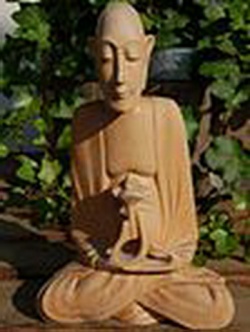Indian Philosophy
Click here to see other articles relating to word Indian Philosophy
Introduction
Indian Philosophy (or, in Sanskrit, Darshanas), refers to any of several traditions of philosophical thought that originated in the Indian subcontinent, including Hindu philosophy, Buddhist philosophy, and Jain philosophy (see below for brief introductions to these schools). It is considered by Indian thinkers to be a practical discipline, and its goal should always be to improve human life.
Orthodox (Hindu) Schools
The main Hindu orthodox (astika) schools of Indian philosophy are those codified during the medieval period of Brahmanic-Sanskritic scholasticism, and they take the ancient Vedas (the oldest sacred texts of Hinduism) as their source and scriptural authority:
Samkhya is the oldest of the orthodox philosophical systems, and it postulates that everything in reality stems from purusha (self or soul or mind) and prakriti (matter, creative agency, energy). It is a dualist philosophy, although between the self and matter rather than between mind and body as in the Western dualist tradition, and liberation occurs with the realization that the soul and the dispositions of matter (steadiness, activity and dullness) are different.
Yoga:
The Yoga school, as expounded by Patanjali in his 2nd Century B.C. Yoga Sutras, accepts the Samkhya psychology and metaphysics, but is more theistic, with the addition of a divine entity to Samkhya's twenty-five elements of reality. The relatively brief Yoga Sutras are divided into eight ashtanga (limbs), reminiscent of Buddhism's Noble Eightfold Path, the goal being to quiet one's mind and achieve kaivalya (solitariness or detachment).
The Nyaya school is based on the Nyaya Sutras, written by Aksapada Gautama in the 2nd Century B.C. Its methodology is based on a system of logic that has subsequently been adopted by the majority of the Indian schools, in much the same way as Aristotelian logic has influenced Western philosophy. Its followers believe that obtaining valid knowledge (the four sources of which are perception, inference, comparison and testimony) is the only way to gain release from suffering. Nyaya developed several criteria by which the knowledge thus obtained was to be considered valid or invalid (equivalent in some ways to Western analytic philosophy).
The Vaisheshika school was founded by Kanada in the 6th Century B.C., and it is atomist and pluralist in nature. The basis of the school's philosophy is that all objects in the physical universe are reducible to a finite number of atoms, and Brahman is regarded as the fundamental force that causes consciousness in these atoms. The Vaisheshika and Nyaya schools eventually merged because of their closely related metaphysical theories (although Vaisheshika only accepted perception and inference as sources of valid knowledge).
The main objective of the Purva Mimamsa school is to interpret and establish the authority of the Vedas. It requires unquestionable faith in the Vedas and the regular performance of the Vedic fire-sacrifices to sustain all the activity of the universe. Although in general the Mimamsa accept the logical and philosophical teachings of the other schools, they insist that salvation can only be attained by acting in accordance with the prescriptions of the Vedas. The school later shifted its views and began to teach the doctrines of Brahman and freedom, allowing for the release or escape of the soul from its constraints through enlightened activity.
The Vedanta, or Uttara Mimamsa, school concentrates on the philosophical teachings of the Upanishads (mystic or spiritual contemplations within the Vedas), rather than the Brahmanas (instructions for ritual and sacrifice). The Vedanta focus on meditation, self-discipline and spiritual connectivity, more than traditional ritualism. Due to the rather cryptic and poetic nature of the Vedanta sutras, the school separated into six sub-schools, each interpreting the texts in its own way and producing its own series of sub-commentaries: Advaita (the best-known, which holds that the soul and Brahman are one and the same), Visishtadvaita (which teaches that the Supreme Being has a definite form, name - Vishnu - and attributes), Dvaita (which espouses a belief in three separate realities:
Vishnu, and eternal soul and matter), Dvaitadvaita (which holds that Brahman exists independently, while soul and matter are dependent), Shuddhadvaita (which believes that Krishna is the absolute form of Brahman) and Acintya Bheda Abheda (which combines monism and dualism by stating that the soul is both distinct and non-distinct from Krishna, or God).
Heterodox (Non-Hindu) Schools
The main heterodox (nastika) schools, which do not accept the authority of the Vedas, include:
Also known as Lokayata, Carvaka is a materialistic, sceptical and atheistic school of thought. Its founder was Carvaka, author of the Barhaspatya Sutras in the final centuries B.C., although the original texts have been lost and our understanding of them is based largely on criticism of the ideas by other schools. As early as the 5th Century, Saddaniti and Buddhaghosa connected the Lokayatas with the Vitandas (or Sophists), and the term Carvaka was first recorded in the 7th Century by the philosopher Purandara, and in the 8th Century by Kamalasila and Haribhadra. As a vital philosophical school, Carvaka appears to have died out some time in the 15th Century.
Buddhism is a non-theistic system of beliefs based on the teachings of Siddhartha Gautama, an Indian prince later known as the Buddha, in the 5th Century B.C. The question of God is largely irrelevant in Buddhism, and it is mainly founded on the rejection of certain orthodox Hindu philosophical concepts (althought it does share some philosophical views with Hinduism, such as belief in karma). Buddhism advocates a Noble Eightfold Path to end suffering, and its philosophical principles are known as the Four Noble Truths (the Nature of Suffering, the Origin of Suffering, the Cessation of Suffering, and the Path Leading to the Cessation of Suffering). Buddhist philosophy deals extensively with problems in metaphysics, phenomenology, ethics and epistemology.
The central tenets of Jain philosophy were established by Mahavira in the 6th Century B.C., although Jainism as a religion is much older. A basic principle is anekantavada, the idea that reality is perceived differently from different points of view, and that no single point of view is completely true (similar to the Western philosophical doctrine of Subjectivism). According to Jainism, only Kevalis, those who have infinite knowledge, can know the true answer, and that all others would only know a part of the answer. It stresses spiritual independence and the equality of all life, with particular emphasis on non-violence, and posits self-control as vital for attaining the realization of the soul's true nature. Jain belief emphasize the immediate consequences of one's behaviour.
The Arthashastra, attributed to the Mauryan minister Chanakya in the 4th Century B.C., is one of the earliest Indian texts devoted to political philosophy, and it discusses ideas of statecraft and economic policy. During the Indian struggle for independence in the early 20th Century, Mahatma Gandhi popularized the philosophies of ahimsa (non-violence) and satyagraha (non-violent resistance), which were influenced by the teachings of the Hindu Bhagavad Gita, as well as Jesus, Tolstoy, Thoreau and Ruskin.


